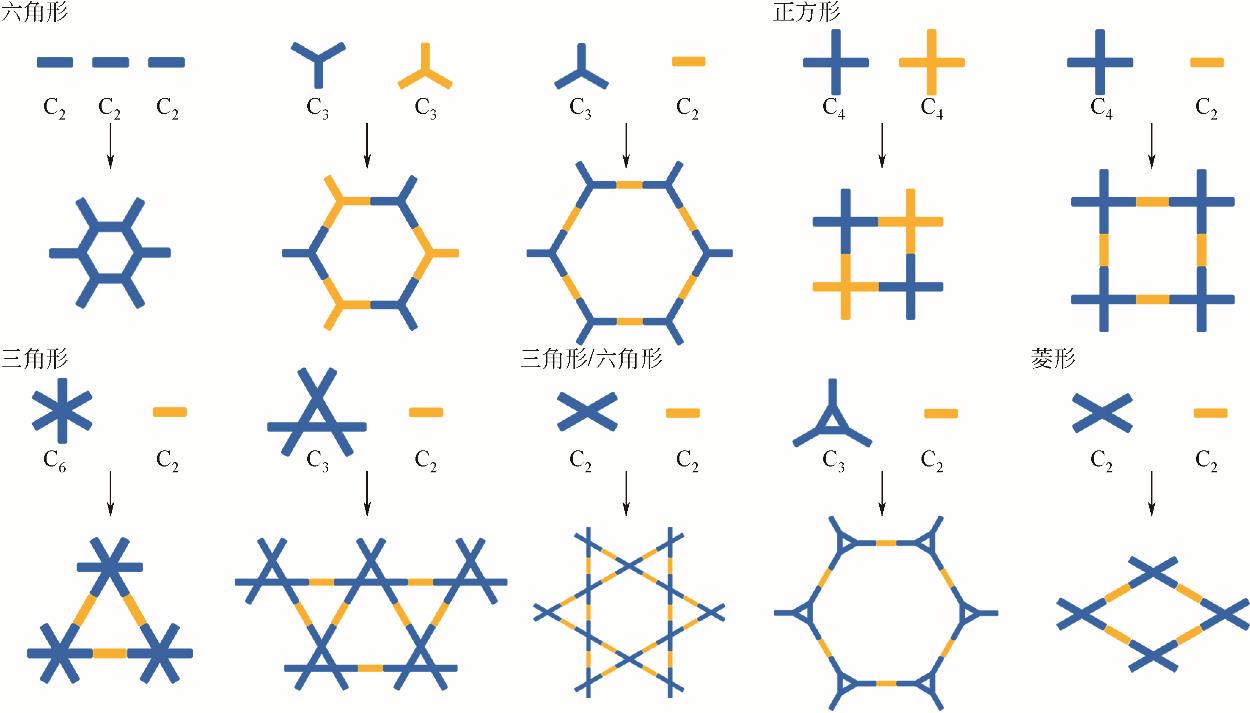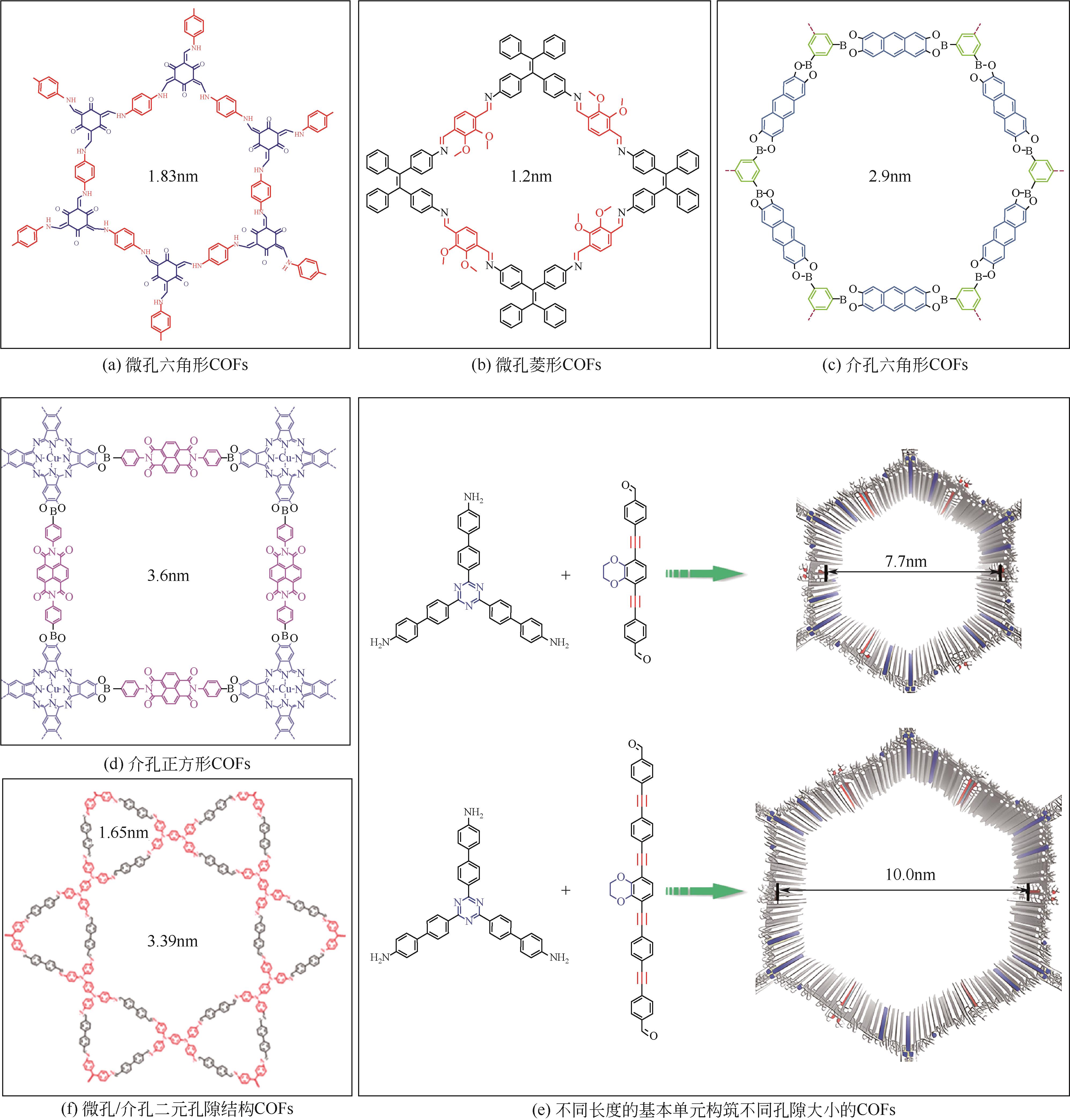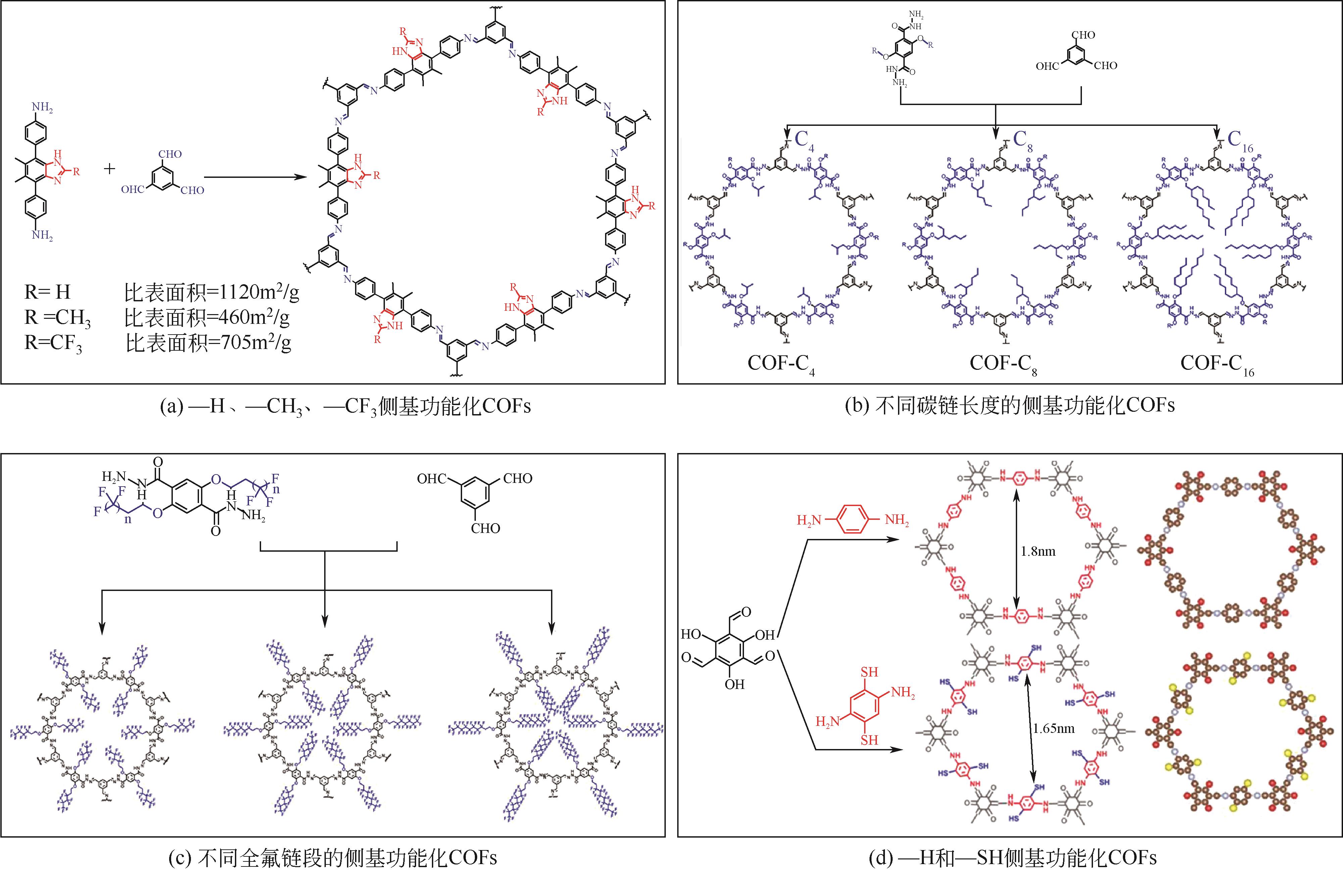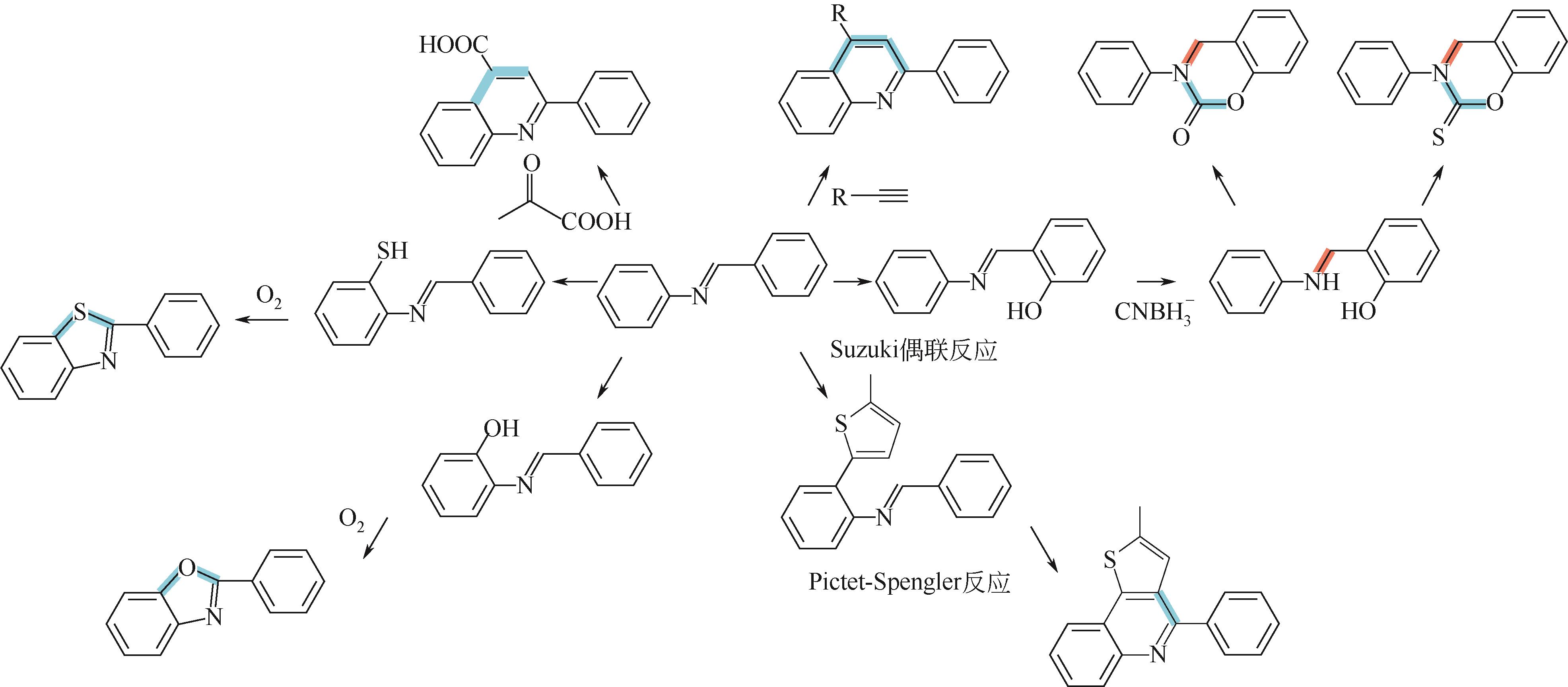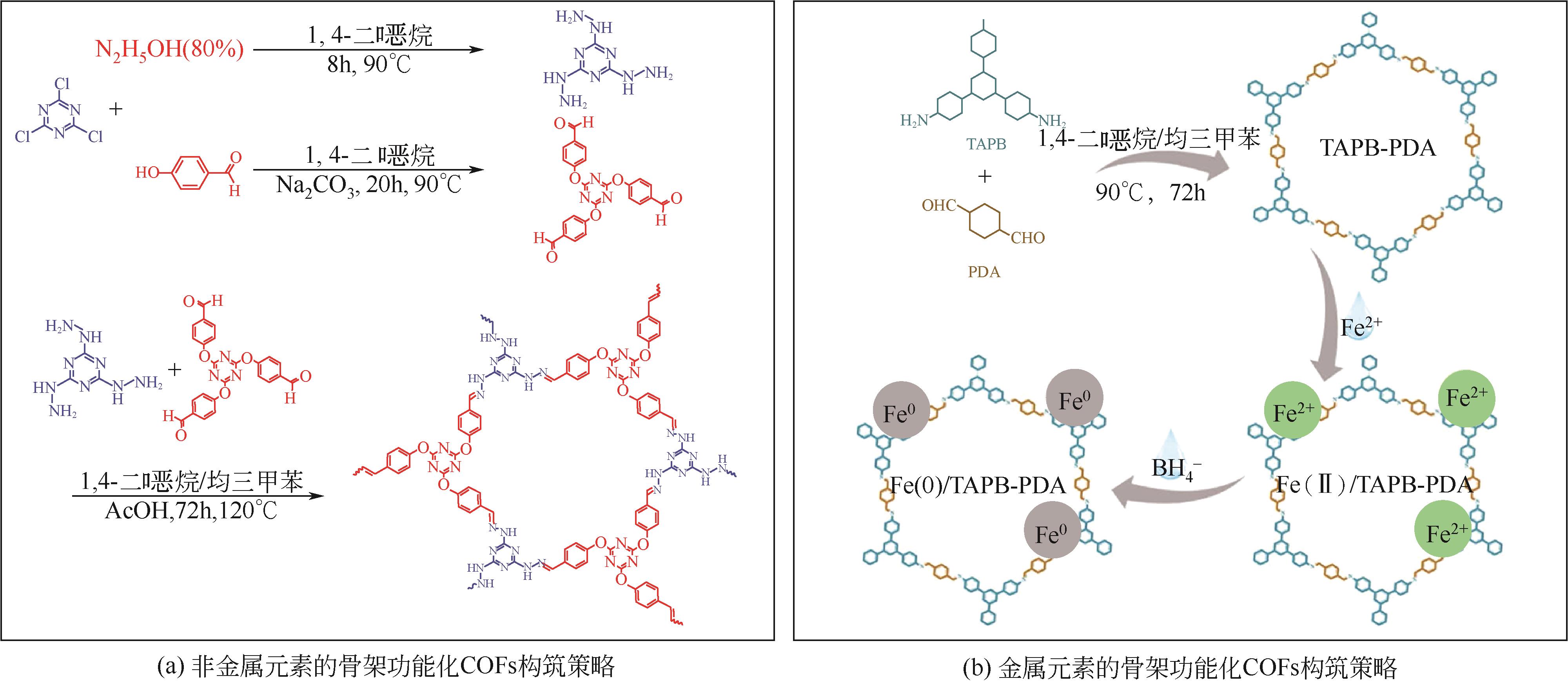化工进展 ›› 2023, Vol. 42 ›› Issue (S1): 461-478.DOI: 10.16085/j.issn.1000-6613.2023-0677
共价有机框架材料功能化策略及其对Hg(Ⅱ)和Cr(Ⅵ)的吸附性能研究进展
许春树1,2( ), 姚庆达2,3, 梁永贤2, 周华龙2,4(
), 姚庆达2,3, 梁永贤2, 周华龙2,4( )
)
- 1.晋江市质量计量检测所,福建 泉州 362200
2.四川大学(石狮)先进高分子材料研究中心,福建 泉州 362700
3.兴业皮革科技股份有限公司,福建 泉州 362200
4.四川大学制革清洁技术国家工程实验室,四川 成都 610000
-
收稿日期:2023-04-24修回日期:2023-10-07出版日期:2023-10-25发布日期:2023-11-30 -
通讯作者:周华龙 -
作者简介:许春树(1981—),男,高级工程师,研究方向为鞋用材料的功能设计及检测分析。E-mail:echose@126.com。 -
基金资助:省部级科学基金(FJQI2012060)
Research progress on functionalization strategies of covalent organic frame materials and its adsorption properties for Hg(Ⅱ) and Cr(Ⅵ)
XU Chunshu1,2( ), YAO Qingda2,3, LIANG Yongxian2, ZHOU Hualong2,4(
), YAO Qingda2,3, LIANG Yongxian2, ZHOU Hualong2,4( )
)
- 1.Jinjiang Testing Institute of Quality and Metrology, Quanzhou 362200, Fujian, China
2.Advanced Polymer Materials Research Center of Sichuan University, Quanzhou 362700, Fujian, China
3.Xingye Leather Technology Co. , Ltd. , Quanzhou 362200, Fujian, China
4.National Engineering Laboratory for Clean Technology of Leather Manufacture, Sichuan University, Chengdu 610000, Sichuan, China
-
Received:2023-04-24Revised:2023-10-07Online:2023-10-25Published:2023-11-30 -
Contact:ZHOU Hualong
摘要:
共价有机框架(COFs)是一类新兴的多孔晶体聚合物材料,具有出色的结构规则性、高度有序的孔径大小、固有的孔隙率、巨大的比表面积、丰富的活性官能团,使其成为吸附水体中各种污染物的理想材料。本文从COFs的拓扑结构设计和孔隙结构设计角度出发,梳理了COFs结构设计要点,而后分析了侧基功能化、官能团转换和骨架功能化等COFs功能化策略,重点阐述了含N、S、O、Fe(0)、Ag(0)等活性官能团、金属/非金属节点对COFs多孔性、水稳定性、吸附性的影响,而后介绍了COFs在去除重金属离子方面的研究进展,详细介绍了COFs对水中典型重金属离子Hg(Ⅱ)和Cr(Ⅵ)的吸附性能,并结合密度泛函理论阐述COFs去除水中重金属离子的作用机理。最后,总结了COFs的功能化策略及功能化COFs作为高性能吸附剂的技术优势,并分析了目前存在的问题,展望未来发展方向,以期对COFs的制备与应用提供参考。
中图分类号:
引用本文
许春树, 姚庆达, 梁永贤, 周华龙. 共价有机框架材料功能化策略及其对Hg(Ⅱ)和Cr(Ⅵ)的吸附性能研究进展[J]. 化工进展, 2023, 42(S1): 461-478.
XU Chunshu, YAO Qingda, LIANG Yongxian, ZHOU Hualong. Research progress on functionalization strategies of covalent organic frame materials and its adsorption properties for Hg(Ⅱ) and Cr(Ⅵ)[J]. Chemical Industry and Engineering Progress, 2023, 42(S1): 461-478.
| COFs | 比表面积/m2·g-1 | 重金属离子 | 吸附pH | 吸附量/mg·g-1 | 循环次数 | 解吸剂 | 参考文献 |
|---|---|---|---|---|---|---|---|
| COF-S-CH3 | 1934 | Hg(Ⅱ) | 7 | 734 | 6 | HCl | [ |
| COF-SH | 546 | Hg(Ⅱ) | 6 | 1350 | — | — | [ |
| DDTA-TPA | 80.14 | Hg(Ⅱ) | 6 | 1445 | 5 | EDTA-2Na | [ |
| TpTch-120 | 216.1 | Hg(Ⅱ) | 7 | 4277 | 4 | HCl和硫脲 | [ |
| RFCOF-SR | 188.6 | Hg(Ⅱ) | 4 | 415.7 | 5 | HCl | [ |
| COF-SH | 235.0 | Hg(Ⅱ) | 7 | 1286.6 | 10 | HCl | [ |
| COF-SO3H | 110.6 | Hg(Ⅱ) | 6 | 1550 | 4 | HCl | [ |
| TAB-DFP | 348.5 | Hg(Ⅱ) | 5 | 837.9 | 5 | HCl和硫脲 | [ |
| BTT-AMPD | 322.96 | Hg(Ⅱ) | — | 476.19 | — | — | [ |
| MTF-TP | 1266 | Hg(Ⅱ) | 7 | 540 | 10 | HCl | [ |
| COF-Ag(0) | 230 | Hg(Ⅱ) | 5 | 113 | 5 | — | [ |
| TPB-DMTP-SH | 291 | Hg(Ⅱ) | 5.6 | 4395 | 4 | HCl | [ |
| COF-SH | 207 | Hg(Ⅱ) | 5 | 763.4 | 5 | HNO3 | [ |
| COF-SH | 1204.6 | Hg(Ⅱ) | 5 | 586.3 | 8 | HCl | [ |
| COF-SH | 1127.71 | Hg(Ⅱ) | 5 | 186.6 | — | — | [ |
表1 部分COFs对典型重金属离子Hg(Ⅱ)的吸附性能总结表
| COFs | 比表面积/m2·g-1 | 重金属离子 | 吸附pH | 吸附量/mg·g-1 | 循环次数 | 解吸剂 | 参考文献 |
|---|---|---|---|---|---|---|---|
| COF-S-CH3 | 1934 | Hg(Ⅱ) | 7 | 734 | 6 | HCl | [ |
| COF-SH | 546 | Hg(Ⅱ) | 6 | 1350 | — | — | [ |
| DDTA-TPA | 80.14 | Hg(Ⅱ) | 6 | 1445 | 5 | EDTA-2Na | [ |
| TpTch-120 | 216.1 | Hg(Ⅱ) | 7 | 4277 | 4 | HCl和硫脲 | [ |
| RFCOF-SR | 188.6 | Hg(Ⅱ) | 4 | 415.7 | 5 | HCl | [ |
| COF-SH | 235.0 | Hg(Ⅱ) | 7 | 1286.6 | 10 | HCl | [ |
| COF-SO3H | 110.6 | Hg(Ⅱ) | 6 | 1550 | 4 | HCl | [ |
| TAB-DFP | 348.5 | Hg(Ⅱ) | 5 | 837.9 | 5 | HCl和硫脲 | [ |
| BTT-AMPD | 322.96 | Hg(Ⅱ) | — | 476.19 | — | — | [ |
| MTF-TP | 1266 | Hg(Ⅱ) | 7 | 540 | 10 | HCl | [ |
| COF-Ag(0) | 230 | Hg(Ⅱ) | 5 | 113 | 5 | — | [ |
| TPB-DMTP-SH | 291 | Hg(Ⅱ) | 5.6 | 4395 | 4 | HCl | [ |
| COF-SH | 207 | Hg(Ⅱ) | 5 | 763.4 | 5 | HNO3 | [ |
| COF-SH | 1204.6 | Hg(Ⅱ) | 5 | 586.3 | 8 | HCl | [ |
| COF-SH | 1127.71 | Hg(Ⅱ) | 5 | 186.6 | — | — | [ |
| COFs | 比表面积/m2·g-1 | 重金属离子 | 吸附pH | 吸附量/mg·g-1 | 循环次数 | 解吸剂 | 参考文献 |
|---|---|---|---|---|---|---|---|
| Tp-At | 17.2 | Cr(Ⅲ) | — | 95.44 | — | — | [ |
| TpTch-90 | 41.99 | Cr(Ⅵ) | 2 | 249.17 | 5 | HCl | [ |
| TpPa-SO3H | 62.5 | Cr(Ⅲ) | — | 105.26 | 5 | HNO3和EDTA | [ |
| COF-OH | 26.4 | Cr(Ⅵ) | 3 | 649.35 | — | — | [ |
| COF-NH2 | 321.1 | Cr(Ⅵ) | 2 | 187.5 | — | — | [ |
| COF-NH2 | 180 | Cr(Ⅵ) | 3 | 304.9 | 5 | NaOH | [ |
| COF-SH | 1127.71 | Cr(Ⅵ) | 5 | 509 | — | — | [ |
| COF-Fe(0) | 102.97 | Cr(Ⅵ) | 1 | 516 | — | — | [ |
表2 部分COFs对典型重金属离子Cr(Ⅲ)和Cr(Ⅵ)的吸附性能总结表
| COFs | 比表面积/m2·g-1 | 重金属离子 | 吸附pH | 吸附量/mg·g-1 | 循环次数 | 解吸剂 | 参考文献 |
|---|---|---|---|---|---|---|---|
| Tp-At | 17.2 | Cr(Ⅲ) | — | 95.44 | — | — | [ |
| TpTch-90 | 41.99 | Cr(Ⅵ) | 2 | 249.17 | 5 | HCl | [ |
| TpPa-SO3H | 62.5 | Cr(Ⅲ) | — | 105.26 | 5 | HNO3和EDTA | [ |
| COF-OH | 26.4 | Cr(Ⅵ) | 3 | 649.35 | — | — | [ |
| COF-NH2 | 321.1 | Cr(Ⅵ) | 2 | 187.5 | — | — | [ |
| COF-NH2 | 180 | Cr(Ⅵ) | 3 | 304.9 | 5 | NaOH | [ |
| COF-SH | 1127.71 | Cr(Ⅵ) | 5 | 509 | — | — | [ |
| COF-Fe(0) | 102.97 | Cr(Ⅵ) | 1 | 516 | — | — | [ |
| 1 | 李若男, 周丽莎, 陈舜胜, 等. 纤维素纳米纤维及其改性产物吸附重金属的研究进展[J]. 化工进展, 2022, 41(1): 310-319. |
| LI Ruonan, ZHOU Lisha, CHEN Shunsheng, et al. Research progress on adsorption of heavy metals by cellulose nanofibers and their modified products[J]. Chemical Industry and Engineering Progress, 2022, 41(1): 310-319. | |
| 2 | 石岩松, 王婧, 崔文杰, 等. 不同形态微塑料和汞对斑马鱼胚胎发育毒性联合作用研究[J]. 中国环境科学, 2023, 43 (4): 1978-1984. |
| SHI Yansong, WANG Jing, CUI Wenjie, et al. Joint effects of microplastics with different shapes and mercury on the developmental toxicity of zebrafish embryos[J]. China Environmental Science, 2023, 43 (4): 1978-1984. | |
| 3 | 徐国豪, 刘英豪, 常明慧, 等. 土壤外源铬的作物毒性响应及富集差异研究[J]. 农业环境科学学报, 2023, 42 (2): 284-290. |
| XU Guohao, LIU Yinghao, CHANG Minghui, et al. Toxicity response and difference in accumulation of exogenous soil chromium in crops[J]. Journal of Agro-Environment Science, 2023, 42 (2): 284-290. | |
| 4 | 张金松, 李冬梅. 新《生活饮用水卫生标准》推动供水行业水质保障体系化建设[J]. 给水排水, 2022, 48(8): 6-12. |
| ZHANG Jinsong, LI Dongmei, New Standards for drinking water quality leads water industry into systematic construction of water quality assurance[J]. Water and Wastewater Engineering, 2022, 48(8): 6-12. | |
| 5 | 姚庆达, 温会涛, 杨长凯, 等. 多层氧化石墨烯膜的结构、性能及在水处理中的应用进展[J]. 材料导报, 2020, 34(15): 15047-15058. |
| YAO Qingda, WEN Huitao, YANG Changkai, et al. Structure and performance of multilayer graphene oxide membrane and its application in water treatment: A review[J]. Materials Reports, 2020, 34(15): 15047-15058. | |
| 6 | 姚庆达, 梁永贤, 王小卓, 等. GO/CS的结构、性能及其在水处理中的应用研究进展[J]. 材料导报, 2022, 36(4): 36-48. |
| Yao Q, Liang Y, Wang X, et al. Structure and performance of graphene oxide/chitosan composite and its application in water treatment: a review [J]. Materials Report, 2022, 36(4): 36-48. | |
| 7 | 梁永贤, 姚庆达, 许春树, 等. 氧化石墨烯和氧化石墨烯/聚乙烯亚胺复合材料对Cu(Ⅱ)的吸附性能研究[J]. 皮革与化工, 2023, 40(1): 1-8. |
| LIANG Yongxian, YAO Qingda, XU Chunshu, et al. Adsorption of C u ( Ⅱ ) by graphene oxide and graphene oxide/polyethylenimine composites[J]. Leather and Chemicals, 2023, 40(1): 1-8. | |
| 8 | 陈琦, 王文涛, 张志鹏, 等. 共价有机框架材料对放射性核素吸附的研究进展[J]. 化工进展, 2021,40(S2): 241-255. |
| CHEN Qi, WANG Wentao, ZHANG Zhipeng, et al. Progress of covalent framework for radionuclides absorption[J]. Chemical Industry and Engineering Progress, 2021,40(S2): 241-255.0 | |
| 9 | 蔡勐, 李新冬, 欧阳国仔, 等. 共价有机框架(COF)对重金属离子吸附去除研究进展[J]. 塑料工业, 2022, 50(10): 21-29. |
| CAI Meng, LI Xindong, OUYANG Guozai, et al. Research progress on adsorption and removal of heavy metal ions by covalent organic frameworks (COFs)[J]. China Plastics Industry, 2022, 50(10): 21-29. | |
| 10 | 唐朝春, 黄从新. 共价有机框架材料吸附去除重金属离子研究进展[J]. 水处理技术, 2022, 48(3): 1-6. |
| TANG Chaochun, HUANG Congxin. Progress in adsorption and removal of heavy metal ions by covalent organic framework materials[J]. Technology of Water Treatment, 2022, 48(3): 1-6. | |
| 11 | 李诗宇, 阴永光, 史建波, 等. 共价有机框架在水中二价汞吸附去除中的应用[J]. 化学进展, 2022, 54(5): 1017-1025. |
| LI Shiyu, YIN Yongguang, SHI Jianbo, et al. Application of covalent organic frameworks in adsorptive removal of divalent mercury from water[J]. Progress in Chemistry, 2022, 54(5): 1017-1025. | |
| 12 | 于潇涵, 黄伟, 李彦光. 二维共价有机框架材料的可控合成及其光催化应用研究进展[J]. 化学学报, 2022, 80(11): 1494-1506. |
| YU Xiaohan, HUANG Wei, LI Yanguang. Controllable synthesis and photocatalytic applications of two-dimensional covalent organic frameworks[J]. Acta Chimica Sinica, 2022, 80(11): 1494-1506. | |
| 13 | 陈育萱, 陈奇, 张占辉, 等. 共价有机框架材料作为非均相配体在有机合成中的应用[J]. 有机化学, 2021, 41: 3826-3843. |
| CHEN Yuxuan, CHEN Qi, ZHANG Zhanhui, et al. Application of covalent organic framework materials as heterogeneous ligands in organic synthesis[J]. Chinese Journal of Organic Chemistry, 2021, 41: 3826-3843. | |
| 14 | LI Yusen, CHEN Qing, XU Tiantian, et al. De novo design and facile synthesis of 2D covalent organic frameworks: A two-in-one strategy[J]. Journal of the American Chemical Society, 2019, 141(35): 13822-13828. |
| 15 | HAO Mengjie, XIE Yinghui, LIU Xiaolu, et al. Modulating uranium extraction performance of multivariate covalent organic frameworks through donor-acceptor linkers and amidoxime nanotraps[J]. JACS Au, 2023, 3(1): 239-251. |
| 16 | HUANG Ning, ZHAI Lipeng, COUPRY Damien E, et al. Multiple-component covalent organic framework[J]. Nature Communications, 2016, 7: 12325. |
| 17 | QI Huaigang, PENG Yu, LV Xinghua, et al. Synergetic effects of COFs interlayer regulation and surface modification on thin-film nanocomposite reverse osmosis membrane with high performance[J]. Desalination, 2023, 548: 116265. |
| 18 | PENG Yongwu, LI Liuxiao, ZHU Chongzhi, et al. intramolecular hydrogen bonding-based topology regulation of two-dimensional covalent organic frameworks[J]. Journal of the American Chemical Society, 2020, 142: 13162-13169. |
| 19 | HUANG Ning, DING Xuesong, KIM Jangbae, et al. A Photoresponsive smart covalent organic framework[J]. Angewandte Communications, 2015, 54: 8704-8707. |
| 20 | QI Yan, ZHANG Jing, ZHANG Li, et al. 3D macro/mesoporous highly reproducible amino-functionalized covalent organic framework nanospheres for fat-rich foodstuffs pretreatment in nontargeted analysis[J]. Chemical Engineering Journal, 2023, 454: 140319. |
| 21 | FREY Laura, JARJU Jenni J, SALONEN Laura M, et al. Boronic-acid-derived covalent organic frameworks: From synthesis to applications[J]. New Journal of Chemistry, 2021, 45: 14879-14907. |
| 22 | MU Zhenjie, ZHU Yuhao, LI Bixiao, et al. Covalent organic frameworks with record pore apertures[J]. Journal of the American Chemical Society, 2022, 144(11): 5145-5454. |
| 23 | FU Shuqing, ZHU Mingzhi, XUE Boxin, et al. Synergy between ionic capacity and intrinsic porosity in imidazolium-based cationic organic polymers and its effect on anionic dye adsorption[J]. Macromolecules, 2022, 55(19): 8784-8794. |
| 24 | ABUZEID Hesham R, EL-MAHDY Ahmed F M, Shiaowei KUO. Hydrogen bonding induces dual porous types with microporous and mesoporous covalent organic frameworks based on bicarbazole units[J]. Microporous and Mesoporous Materials, 2020, 300: 110151. |
| 25 | LI Xianghua, TANG Huaijun, GAO Long, et al. A sp2-carbon-linked covalent organic framework containing tetraphenylethene units used as yellow phosphors in white light-emitting diodes[J]. Polymer, 2022, 241: 124474. |
| 26 | LI Wei, JIANG Hongxin, CUI Mengfan, et al. SiO2 templates-derived hierarchical porous COFs sample pretreatment tool for non-targeted analysis of chemicals in foods[J]. Journal of Hazardous Materials, 2022, 432: 128705. |
| 27 | DIERCKS Christian S, LIN Song, KORNIENKO Nikolay, et al. Reticular electronic tuning of porphyrin active sites in covalent organic frameworks for electrocatalytic carbon dioxide reduction[J]. Journal of the American Chemical Society, 2018, 140: 1116-1122. |
| 28 | HU Yiming, DUNLAP Nathan, WAN Shun, et al. Crystalline lithium imidazolate covalent organic frameworks with high Li-ion conductivity[J]. Journal of the American Chemical Society, 2019, 141: 7518-7525. |
| 29 | SHINDE Digambar B, CAO Li, LIU Xiaowei, et al. Tailored pore size and microporosity of covalent organic framework (COF) membranes for improved molecular separation[J]. Journal of Membrane Science Letters, 2021, 1(2): 100008. |
| 30 | LIU Ziya, ZHANG Kun, HUANG Guoji, et al. Highly processable covalent organic framework gel electrolyte enabled by side-chain engineering for lithium-ion batteries[J]. Angewandte Chemie, 2022, 61(2): e202110695. |
| 31 | HUANG Ning, ZHAI Lipeng, XU Hong, et al. Stable covalent organic frameworks for exceptional mercury removal from aqueous solutions[J]. Journal of the American Chemical Society, 2017, 139(6): 2428-2434. |
| 32 | LIU Jiao, YANG Tong, WANG Zhipeng, et al. Pyrimidazole-based covalent organic frameworks: Integrating functionality and ultrastability via isocyanide chemistry[J]. Journal of the American Chemical Society, 2020, 142: 20956-20961. |
| 33 | WU Xiaowei, HONG Youle, XU Bingqing, et al. Perfluoroalkyl-functionalized covalent organic frameworks with superhydrophobicity for anhydrous proton conduction[J]. Journal of the American Chemical Society, 2020, 142(33): 14357-14364 |
| 34 | LIU Ruiqi, HUANG Lijin, TAO Hui, et al. Microenvironment engineering of covalent organic frameworks for the efficient removal of sulfamerazine from aqueous solution[J]. Journal of Environmental Chemical Engineering, 2022, 10(2): 107300. |
| 35 | CAO Ying, HU Xue, ZHU Changqian, et al. Sulfhydryl functionalized covalent organic framework as an efficient adsorbent for selective P b ( Ⅱ ) removal[J]. Colloids and Surfaces A: Physicochemical and Engineering Aspects, 2020, 600: 125004. |
| 36 | LU Zhenwu, YANG Chunying, HE Liu, et al. Asymmetric hydrophosphonylation of imines to construct highly stable covalent organic frameworks with efficient intrinsic proton conductivity[J]. Journal of the American Chemical Society, 2022, 144(22): 9624-9633. |
| 37 | YANG Yixuan, TANG Xihao, WU Jialin, et al. Transformation of a hydrazone-linked covalent organic framework into a highly stable hydrazide-linked one[J]. ACS Applied Polymer Materials, 2022, 4(7): 4624-4631. |
| 38 | KANG Jinyang, HANG Jiahui, CHEN Bo, et al. Amide linkages in pyrene-based covalent organic frameworks toward efficient photocatalytic reduction of uranyl[J]. ACS Applied Polymer Materials, 2022, 14(51): 57225-57234. |
| 39 | ZHANG Gen, TSUJIMOTO Masahiko, PACKWOOD Daniel, et al. Construction of a hierarchical architecture of covalent organic frameworks via a postsynthetic approach[J]. Journal of the American Chemical Society, 2018, 140(7): 2602-2609. |
| 40 | MASCHITA Johannes, BANERJEE Tanmay, LOTSCH Bettina V. Direct and linker-exchange alcohol-assisted hydrothermal synthesis of imide-linked covalent organic frameworks[J]. Chemistry of Materials, 2022, 34(5): 2249-2258. |
| 41 | NAGAI Atsushi, GUO Zhaoqi, FENG Xiao, et al. Pore surface engineering in covalent organic frameworks[J]. Nature Communications, 2011, 2: 536. |
| 42 | HUANG Ning, KRISHNA Rajamani, JIANG Donglin. Tailor-made pore surface engineering in covalent organic frameworks: Systematic functionalization for performance screening[J]. Journal of the American Chemical Society, 2015, 137(22): 7079-7082. |
| 43 | CHEN Long, FURUKAWA Ko, GAO Jia, et al. Photoelectric covalent organic frameworks: Converting open lattices into ordered donor–acceptor heterojunctions[J]. Journal of the American Chemical Society, 2014, 136(28): 9806-9809. |
| 44 | SUN Qi, AGUILA Briana, PERMAN Jason, et al. Postsynthetically modified covalent organic frameworks for efficient and effective mercury removal[J]. Journal of the American Chemical Society, 2017, 139(7): 2786-2793. |
| 45 | XIAO Saijin, QIU Anting, LI Huihan, et al. Simultaneous detection and separation of uranium based on a fluorescent amidoxime-functionalized covalent organic polymer[J]. Spectrochimica Acta A: Molecular and Biomolecular Spectroscopy, 2023, 289(15): 122182. |
| 46 | LU Qiuyu, MA Yunchao, LI Hui, et al. Postsynthetic functionalization of three-dimensional covalent organic frameworks for selective extraction of lanthanide ions[J]. Angewandte Chemie, 2018, 57(21): 6042-6048. |
| 47 | YANG Yongliang, YU Ling, CHU Tiancheng, et al. Constructing chemical stable 4-carboxyl-quinoline linked covalent organic frameworks via Doebner reaction for nanofiltration[J]. Nature Communications, 2022, 13: 2615. |
| 48 | GUAN Xinyu, LI Hui, MA Yunchao, et al. Chemically stable polyarylether-based covalent organic frameworks[J]. Nature Chemistry, 2019, 11: 587-594. |
| 49 | ZHANG Shuyuan, TANG Xihao, YAN Yilun, et al. Facile and site-selective synthesis of an amine-functionalized covalent organic framework[J]. ACS Macro Letters, 2021, 10(12): 1590-1596. |
| 50 | WANG Yuancheng, LIU Hui, PAN Qingyan, et al. Construction of fully conjugated covalent organic frameworks via facile linkage conversion for efficient photoenzymatic catalysis[J]. Journal of the American Chemical Society, 2020, 142(13): 5958-5963. |
| 51 | VEDACHALAM Seenuvasan, SEKAR Pandiaraj, NITHYA Chandrasekaran, et al. Dopant-free main group elements supported covalent organic-inorganic hybrid conducting polymer for sodium-ion battery application[J]. ACS Applied Energy Materials, 2022, 5(1): 557-566. |
| 52 | ALMANSAF Zainab, HU Jiyun, ZANCA Federica, et al. P t ( Ⅱ ) -decorated covalent organic framework for photocatalytic difluoroalkylation and oxidative cyclization reactions[J]. ACS Applied Materials and Interfaces, 2021, 13(5): 6349-6358. |
| 53 | DURKA Krzysztof, KAZIMIERCZUK Krzysztof, Sergiusz LULIŃSKI. Dipole-dipole interactions of sulfone groups as a tool for self-assembly of a 2D covalent organic framework derived from a non-linear diboronic acid[J]. Microporous and Mesoporous Materials, 2022, 337: 111914. |
| 54 | HAASE Frederik, TROSCHKE Erik, Gökcen SAVASCI, et al. Topochemical conversion of an imine- into a thiazole-linked covalent organic framework enabling real structure analysis[J]. Nature Communications, 2018, 9: 2600. |
| 55 | LI Xinle, ZHANG Changlin, CAI Songliang, et al. Facile transformation of imine covalent organic frameworks into ultrastable crystalline porous aromatic frameworks[J]. Nature Communications, 2018, 9: 2998. |
| 56 | Prasenjit DAS, CHAKRABORTY Gouri, Roeser JÉRÔME, et al. Integrating bifunctionality and chemical stability in covalent organic frameworks via one-pot multicomponent reactions for solar-driven H2O2 production[J]. Journal of the American Chemical Society, 2023, 145(5): 2975-2984. |
| 57 | WALLER Peter J, ALFARAJ Yasmeen S, DIERECKS Christian S, et al. Conversion of imine to oxazole and thiazole linkages in covalent organic frameworks[J]. Journal of the American Chemical Society, 2018, 140(29): 9099-9103. |
| 58 | SEO Jeong Min, Hyuk Jun NOH, JEONG Hu Young, et al. Converting unstable imine-linked network into stable aromatic benzoxazole-linked one via post-oxidative cyclization4[J]. Journal of the American Chemical Society, 2019, 141(30): 11786-11790. |
| 59 | LYLE Steven J, POPP Thomas M Osborn, WALLER Peter J, et al. Multistep solid-state organic synthesis of carbamate-linked covalent organic frameworks[J]. Journal of the American Chemical Society, 2019, 141(28): 11253-11258. |
| 60 | WANG Yuancheng, LIU Hui, PAN Qingyan, et al. Construction of fully conjugated covalent organic frameworks via facile linkage conversion for efficient photoenzymatic catalysis[J]. Journal of the American Chemical Society, 2020, 142(13): 5958-5963. |
| 61 | DINARI Mohammad, HATAMI Mohammad. Novel N-riched crystalline covalent organic framework as a highly porous adsorbent for effective cadmium removal[J]. Journal of Environmental Chemical Engineering, 2019, 7: 102907. |
| 62 | LI Yongqiang, WANG Quan, JU Yuhua, et al. Novel pyridine-based covalent organic framework containing N,N,N-chelating sites for selective detection and effective removal of nickel[J]. Inorganic Chemistry Frontiers, 2022, 9: 3845. |
| 63 | LI Dianmei, LI Shuqing, HUANG Jiayi, et al. A recyclable bipyridine-containing covalent organic framework-based QCM sensor for detection of Hg(Ⅱ) ion in aqueous solution[J]. Journal of Solid State Chemistry, 2021, 302: 122421. |
| 64 | ZHANG Yanbo, WANG Quan, LI Yongqiang, et al. Bithiophene-based COFs for silver ions detection and removal[J]. Microporous and Mesoporous Materials, 2022, 346: 112289. |
| 65 | LIU Xiaoshuang, XU Haomiao, WANG Longlong, et al. Surface nano-traps of Fe0/COFs for arsenic(Ⅲ) depth removal from wastewater in non-ferrous smelting industry[J]. Chemical Engineering Journal, 2020, 381: 122559. |
| 66 | LI Wei, LI Yang, QIAN Hailong, et al. Fabrication of a covalent organic framework and its gold nanoparticle hybrids as stable mimetic peroxidase for sensitive and selective colorimetric detection of mercury in water samples[J]. Talanta, 2019, 204: 224-228. |
| 67 | SHI Zhixiong, CHEN Zhuo, ZHANG Yan, et al. COF TzDa/Ag/AgBr Z-scheme heterojunction photocatalyst for efficient visible light driven elimination of antibiotics tetracycline and heavy metal ion Cr(Ⅵ)[J]. Separation and Purification Technology, 2022, 288: 120717. |
| 68 | WU Zhongjia, ZHU Junlun, WEN Wei, et al. Spherical covalent organic framework supported Cu/Ag bimetallic nanoparticles with highly catalytic activity for reduction of 4-nitrophenol[J]. Journal of Solid State Chemistry, 2022, 311: 123116. |
| 69 | DONG Zhaoyi, YANG Yixuan, CAI Xinting, et al. Site-selective synthesis of an amine-functionalized β-ketoenamine-linked covalent organic framework for improved detection and removal of Cu2+ ion from water[J]. Journal of Solid State Chemistry, 2022, 316: 123644. |
| 70 | HAN Jiajia, PEI Longsheng, SU Jianpo, et al. A novel covalent organic framework with abundant N—O—O and N—N—O sites for detection and removal of Zn2+, Cd2+, Pb2+, Cu2+, and Hg2+ [J]. Ionics, 2023, 29: 807-817. |
| 71 | HUSSAIN Muzammil, MAILE Nagesh, TAHIR Khurram, et al. Flexible thiourea-based covalent organic frameworks for ultrahigh mercury removal from aqueous solutions[J]. Chemical Engineering Journal, 2022, 446: 137410. |
| 72 | LI Xiaofeng, JIA Zhimin, ZHANG Jie, et al. Construction of covalent organic frameworks with alternating rigid and flexible units and their controlled release of active sites[J]. Chemical Engineering Journal, 2023, 454: 140119.2 |
| 73 | MAZhiyao, LIU Fuyang, LIU Nengsheng, et al. Facile synthesis of sulfhydryl modified covalent organic frameworks for high efficient H g ( Ⅱ ) removal from water[J].Journal of Hazardous Materials, 2021, 405: 124190. |
| 74 | TAO Yuan, XIONG Xiaohong, XIONG Jianbo, et al. High-performance removal of mercury ions (Ⅱ) and mercury vapor by SO3 --anchored covalent organic framework[J]. Journal of Solid State Chemistry, 2020, 282: 121126. |
| 75 | YU Yanxin, LI Guoliang, LIU Jianghua, et al. A recyclable fluorescent covalent organic framework for exclusive detection and removal of mercury(Ⅱ)[J]. Chemical Engineering Journal, 2020, 401: 126139. |
| 76 | FU Quanbin, ZHANG Tingting, SUN Xin, et al. Pyridine-based covalent organic framework for efficient and selective removal of H g ( Ⅱ ) from water: Adsorption behavior and adsorption mechanism investigations[J]. Chemical Engineering Journal, 2023, 454: 140154. |
| 77 | LI Yang, SONG Yonghai, LI Junjie, et al. S, N-rich luminous covalent organic frameworks for Hg2+ detection and removal[J]. Chemosphere, 2023, 311: 136919. |
| 78 | RAJALAKSHMI Kanagaraj, MUTHUSAMY Selvaraj, XIE Meng, et al. Fabrication of thiophene decorated side chain entanglement free COFs for highly regenerable mercury extraction[J]. Chemical Engineering Journal, 2022, 430: 133149. |
| 79 | WANG Longlong, XU Haomiao, QIU Yixiang, et al. Utilization of Ag nanoparticles anchored in covalent organic frameworks for mercury removal from acidic waste water[J]. Journal of Hazardous Materials, 2020, 389(5): 121824. |
| 80 | Laura MERÍ-BOFÍ, ROYUELA Sergio, ZAMORA Félix, et al. Thiol grafted imine-based covalent organic frameworks for water remediation through selective removal of Hg ( Ⅱ ) [J]. Journal of Materials Chemistry A, 2017, 5: 17973-17981. |
| 81 | PAN Fei, TONG Chunyi, WANG Zhaoyang, et al. Novel sulfhydryl functionalized covalent organic frameworks for ultra-trace Hg2+ removal from aqueous solution[J]. Journal of Materials Science and Technology, 2021, 93: 89-95. |
| 82 | WANG Wei, GONG Minjuan, ZHU Donghai, et al. Post-synthetic thiol modification of covalent organic frameworks for mercury ( Ⅱ ) removal from water[J]. Environmental Science and Ecotechnology, 2023, 14: 100236. |
| 83 | WANG Heping, FENG Bang, ZHANG Qianwen, et al. Amidinothiourea-linked covalent organic framework for the adsorption of heavy metal ions[J]. Polymer International, 2022, 71(1): 38-46. |
| 84 | ZHANG Xiaoqin, HAO Jun, ZHENG Xiaoshan, et al. High-performance adsorption of chromate by hydrazone-linked guanidinium-based ionic covalent organic frameworks: Selective ion exchange[J]. Separation and Purification Technology, 2021, 274: 118993. |
| 85 | WANG Heping, WANG Ting, MA Rongrong, et al. Facile synthesis of sulfonated covalent organic framework for the adsorption of heavy metal ions[J]. Journal of the Taiwan Institute of Chemical Engineers, 2020, 112: 122-129. |
| 86 | ZHU Donghai, ZHOU SHuangxi, ZHOU Ziming, et al. Highly efficient and selective removal of C r ( Ⅵ ) by covalent organic frameworks: Structure, performance and mechanism[J]. Colloids and Surfaces A: Physicochemical and Engineering Aspects, 2020, 600(5): 124910. |
| 87 | LIU Haowei, ZHANG Xiaofan, HOU Lumiao, et al. Nitrogen-rich hierarchical porous polyphosphazene for rapid and efficient adsorption of anionic contaminants: Kinetics, isotherm, thermodynamics and mechanism[J]. Applied Surface Science, 2023, 616: 156538. |
| 88 | KONG Ke, CHENG Bo, LIANG Jun, et al. The aminated covalent organic polymers for reversible removal of concurrent perfluorooctane sulfonate and dichromate[J]. Chemical Engineering Journal, 2022, 446: 137343. |
| 89 | ZHANG Hourui, ZHANG Lu, DONG Shuangshi, et al. Regulating energy band structures of triazine covalent organic frameworks with electron-donating/withdrawing substituents for visible-light-responsive photocatalytic tetracycline degradation and Cr(Ⅵ) reduction[J]. Journal of Hazardous Materials, 2023, 446: 130756. |
| 90 | YANG Yanan, ZHANG Yu, ZHENG Hong, et al. Functionalized dual modification of covalent organic framework for efficient and rapid trace heavy metals removal from drinking water[J]. Chemosphere, 2022, 290: 133215. |
| 91 | CHEN Weiben, YANG Zongfan, XIE Zhen, et al. Benzothiadiazole functionalized D-A type covalent organic frameworks for effective photocatalytic reduction of aqueous chromium ( Ⅵ ) [J]. Journal of Materials Chemistry A, 2019, 7: 998. |
| 92 | QIN Na, MAO Aojie, LI Linqiang, et al. Construction of benzothiadiazole-based D-A covalent organic frameworks for photocatalytic reduction of C r ( Ⅵ ) and synergistic elimination of organic pollutants[J]. Polymer, 2022, 262: 125483. |
| 93 | SHEN Huizhen, CHEN Li, ZHOU Cailong, et al. Immobilizing Fe0 nanoparticles on covalent organic framework towards enhancement of C r ( Ⅵ ) removal by adsorption and reduction synergistic effect[J]. Separation and Purification Technology, 2022, 290: 120883. |
| 94 | ZHANG Shun, LAN Huachun, CUI Yuqi, et al. Insight into the key role of cr intermediates in the efficient and simultaneous degradation of organic contaminants and C r ( Ⅵ ) reduction via g-C3N4-assisted photocatalysis[J]. Environmental Science and Technology, 2022, 56(6): 3552-3563. |
| 95 | GAO Ya, YI Xiaohong, WANG Chongchen, et al. Effective C r ( Ⅵ ) reduction over high throughput Bi-BDC MOF photocatalyst[J]. Materials Research Bulletin, 2023, 158: 112072. |
| 96 | LI Fei, ZHANG Guang. Effective removal of toxic heavy metal ions from wastewater using boroxine covalent organic framework[J]. Journal of Molecular Liquids, 2021, 336: 116326. |
| 97 | ZHANG Anrui, LIU Xuewei, HONG Jiahui, et al. A mussel-pearl side chain interaction in mercury ( Ⅱ ) and phenol removal by sulfur-functionalized covalent organic frameworks: A DFT study[J]. Science of the Total Environment, 2022, 838(2): 156082. |
| 98 | HUANG Zhen, XIONG Chao, YING Lingri, et al. Facile synthesis of a MOF-derived magnetic CoAl-LDH@chitosan composite for P b ( Ⅱ ) and C r ( Ⅵ ) adsorption[J]. Chemical Engineering Journal, 2022, 449: 137722. |
| [1] | 王胜岩, 邓帅, 赵睿恺. 变电吸附二氧化碳捕集技术研究进展[J]. 化工进展, 2023, 42(S1): 233-245. |
| [2] | 胡喜, 王明珊, 李恩智, 黄思鸣, 陈俊臣, 郭秉淑, 于博, 马志远, 李星. 二硫化钨复合材料制备与储钠性能研究进展[J]. 化工进展, 2023, 42(S1): 344-355. |
| [3] | 崔守成, 徐洪波, 彭楠. 两种MOFs材料用于O2/He吸附分离的模拟分析[J]. 化工进展, 2023, 42(S1): 382-390. |
| [4] | 陈崇明, 陈秋, 宫云茜, 车凯, 郁金星, 孙楠楠. 分子筛基CO2吸附剂研究进展[J]. 化工进展, 2023, 42(S1): 411-419. |
| [5] | 顾永正, 张永生. HBr改性飞灰对Hg0的动态吸附及动力学模型[J]. 化工进展, 2023, 42(S1): 498-509. |
| [6] | 赵景超, 谭明. 表面活性剂对电渗析减量化工业含盐废水的影响[J]. 化工进展, 2023, 42(S1): 529-535. |
| [7] | 郭强, 赵文凯, 肖永厚. 增强流体扰动强化变压吸附甲硫醚/氮气分离的数值模拟[J]. 化工进展, 2023, 42(S1): 64-72. |
| [8] | 葛亚粉, 孙宇, 肖鹏, 刘琦, 刘波, 孙成蓥, 巩雁军. 分子筛去除VOCs的研究进展[J]. 化工进展, 2023, 42(9): 4716-4730. |
| [9] | 王晨, 白浩良, 康雪. 大功率UV-LED散热与纳米TiO2光催化酸性红26耦合系统性能[J]. 化工进展, 2023, 42(9): 4905-4916. |
| [10] | 王琦, 寇丽红, 王冠宇, 王吉坤, 刘敏, 李兰廷, 王昊. 焦化废水生物出水中可溶解性有机物的分子识别[J]. 化工进展, 2023, 42(9): 4984-4993. |
| [11] | 史天茜, 石永辉, 武新颖, 张益豪, 秦哲, 赵春霞, 路达. Fe2+对厌氧氨氧化EGSB反应器运行性能的影响[J]. 化工进展, 2023, 42(9): 5003-5010. |
| [12] | 杨莹, 侯豪杰, 黄瑞, 崔煜, 王兵, 刘健, 鲍卫仁, 常丽萍, 王建成, 韩丽娜. 利用煤焦油中酚类物质Stöber法制备碳纳米球用于CO2吸附[J]. 化工进展, 2023, 42(9): 5011-5018. |
| [13] | 张振, 李丹, 陈辰, 吴菁岚, 应汉杰, 乔浩. 吸附树脂对唾液酸的分离纯化[J]. 化工进展, 2023, 42(8): 4153-4158. |
| [14] | 郑梦启, 王成业, 汪炎, 王伟, 袁守军, 胡真虎, 何春华, 王杰, 梅红. 菌藻共生技术在工业废水零排放中的应用与展望[J]. 化工进展, 2023, 42(8): 4424-4431. |
| [15] | 姜晶, 陈霄宇, 张瑞妍, 盛光遥. 载锰生物炭制备及其在环境修复中应用研究进展[J]. 化工进展, 2023, 42(8): 4385-4397. |
| 阅读次数 | ||||||
|
全文 |
|
|||||
|
摘要 |
|
|||||

